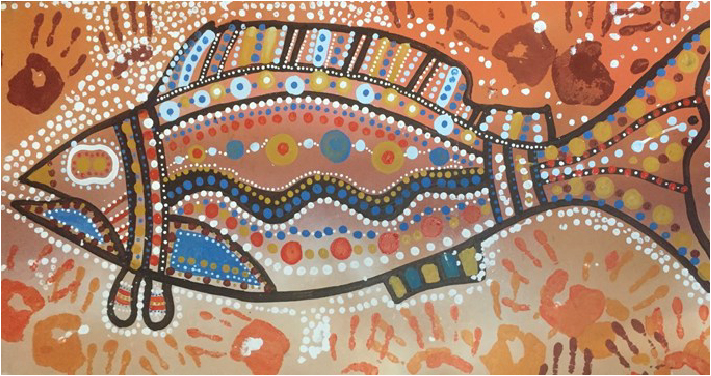
Acknowledgment of Country
We acknowledge the Traditional Custodians of Hunters Hill and show respect to
Elders past and present.
Please note:
Aboriginal and Torres Strait Islander people should be aware that this booklet contains images and names of deceased persons in photographs and printed material.
Some material contains terms that reflect views of the period in which the item was written. While the information may not reflect current understanding, it is provided in a historical context.
Wallumedegal Clan: The First Residents of Hunters Hill
From as early as 60 000 years ago, the Wallumedegal people could have
inhabited the region. The arrival of the Europeans in February 1788 had a
devastating impact on their population and way of life. This can be attributed to
the introduction of smallpox disease, the clearing of Aboriginal land to plant
crops and the push to adopt European customs culminating in the Australian
Assimilation Policies.
Their name derived from the word for Snapper, Wallumai, and Matta,
which means “place of water”. According to Lieutenant Philip Gidley,
Wallumedegal was used to refer to the clan itself as well as its male members,
whilst Wallemedegalleon was used to refer to the female members. In the
historical documents, there are variations in the spelling of the clan name, with
Wallumettagal and Wattamattagal also being used. This can be explained by the
oral nature of the Darug language. Early colonists documented the clan name
according to how they perceived its pronunciation.
Geography
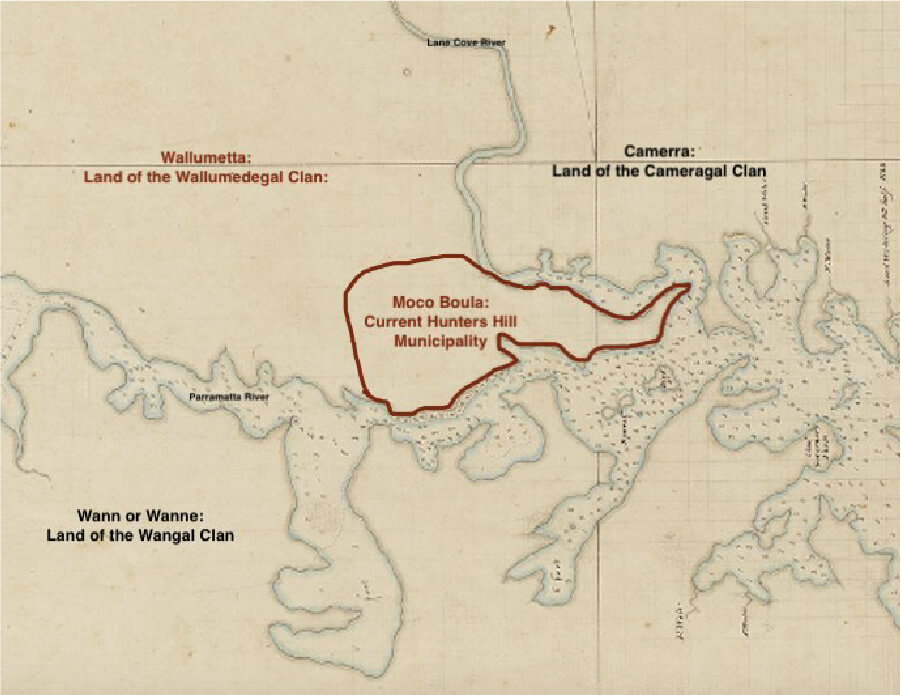
According to Governor Phillip, Captain Louis de Freycinet and Lieutenant Philip Gidley King, the Wallumedegal clan occupied the northern shore of the Paramatta River, incorporating the area now known as the Hunters Hill-Woolwich Peninsula. This peninsula was named Moco Boula or ‘Two waters’ by local resident Jules Joubert in a letter dated 27 October 1860.
Moco Boula was high, rocky and densely covered with turpentine, ironbark, eucalyptus, white stringybark and bloodwood trees. According to Captain Louis Freycinet, it was the eastern limit of the Wallumedegal clan’s land, Wallumetta.
The Lane Cove and Parramatta rivers acted as natural barriers which separated Wallumetta from Camerra, the land of the Cameragal clan, and Wann/e, the land of the Wangal clan. However, there is no record of the northern boundary of Wallumetta.
Language
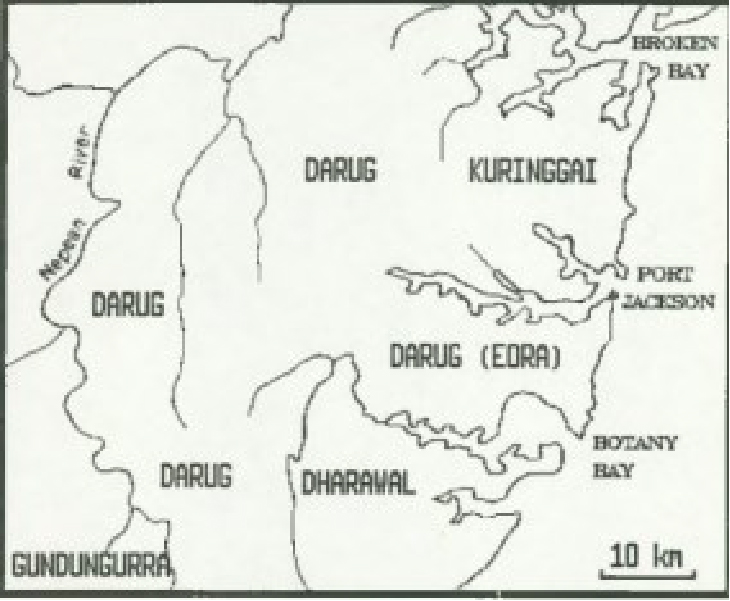
The Wallumedegal people spoke a dialect of the Darug language which was specific to the Sydney coastal region extending from Botany Bay to Pittwater and Parramatta. Therefore, they spoke the same dialect as their neighbouring clans. No authentic name was recorded for this dialect and hence it has been referred to as the Eora, Guringai or Sydney language. Neighbouring languages included other Darug dialects and Dharawal, Kuringgai and Gundungurra languages.
Colonial historical records are our only source of information for piecing together the stories of a once-thriving, expressive and humorous oral culture. The pioneer William Dawes (1762-1836) was instrumental in documenting the Darug language as he recorded conversational snippets, which surpassed the simple wordlists of encountered items compiled by other colonists. Of upmost importance was Dawes’ relationship with Patyegarang, a young Darug woman who taught Dawes the Sydney language.
Today there are a large number of speakers of the Darug language and big efforts are being made to revive it through various courses including those at TAFE and Macquarie University.
Educational Activities
- Have a go at pronouncing some of the following words:
- Can you locate these words under the subheadings below?
Moco Boula (two waters)
Wallumai (Black Snapper)
Metta (place of water)
Nuwi (canoe or boat)
Balagaman (Aboriginal Person)
Wadyiman (non-Aboriginal Person)
Womara (spear thrower with flat shell end)
Wiggon (spear thrower with rounded shell end)
Mogo (stone hatchet or axe)
Mittayon (smallpox disease)
Goinnia (canoe paddle)
Callar (large fishing spear)
Mooting (small fishing spear)
Carrejun (fishing line)
Burra (fishhook)
Gna’mmul (small stone)
Mudjil (red)
Badangi (Sydney Rock Oyster)
Dagal (mussel)
Gadyan (Sydney Cockle)
Ngurra (a camp)
Buwabili (buried)
Mudjil (red)
Dyirra (white)
Dunga (to weep or cry, literally: to howl like a dingo)
Fishing, Hunting and Gathering
All members of the Wallumedegal clan played a role in acquiring food. Gathering of edible plants, shellfish and smaller animals was usually the task of Wallumedegal women, whilst the men were responsible for the hunting of larger game. However, both men and women played a role in catching fish, including the abundant snapper alongside mullet, bream, jewfish and mackerel. As they occupied the coastal area, the diet of the Wallumedegal people was predominantly fish and shellfish, supplemented with birds, game and edible plants. Traditional Wallumedegal fishing techniques endured British Settlement, with fish being a valuable item to exchange for food and clothing, whilst hunting and gathering was generally abandoned due to land clearance for crops and buildings which depleted traditional food sources.
How did women fish?
Women, accompanied by their children, usually fished with hooks and lines from bark canoes and occasionally from rock platforms. Hand fishing lines, carrejun, were spun from the bark of the kurrajong tree. According to Surgeon John White, they were soaked in a solution of sap from the red bloodwood tree to prevent fraying.
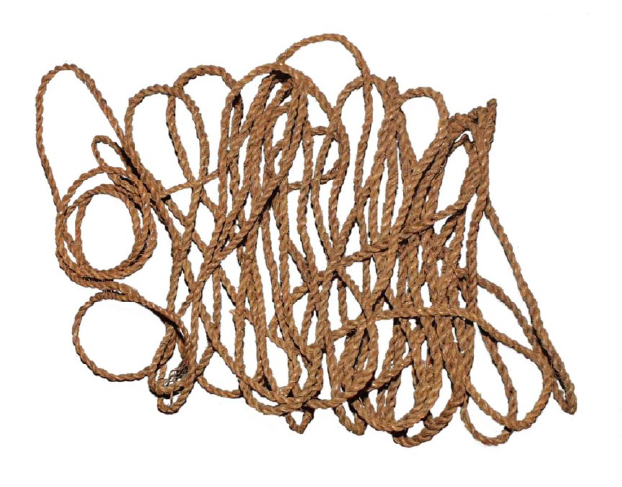
Attached to these fishing lines were burra or fishhooks, which were made by shaping turban seashells into a crescent shape using a stone file, and small stones, gna’mmul, which were used as sinkers. As bait was not attached to the burra, chewed muscles, fish or cockles were spat into the water to attract fish.
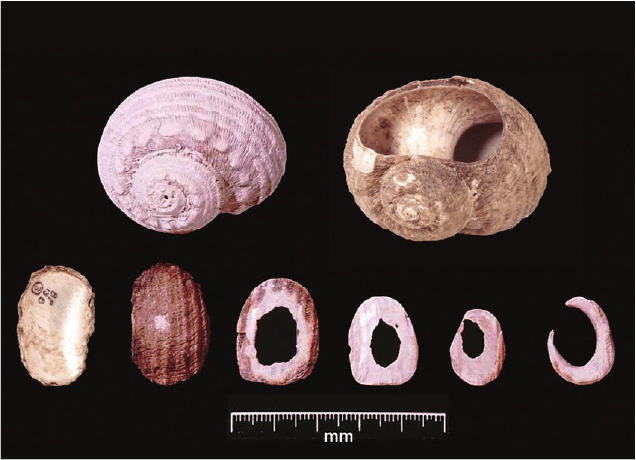
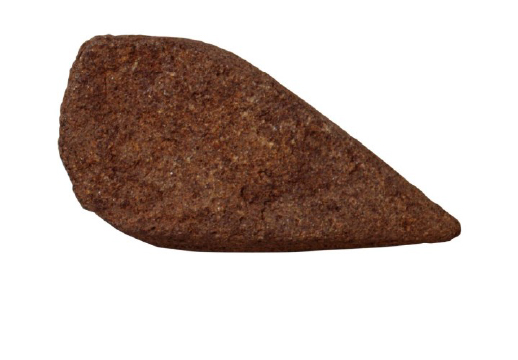
How did men fish?
Men fished with multi-pronged spears (fizz-gigs), which they launched by hand whilst standing on rock platforms, in shallow water or in bark canoes. There were two types of fishing spears: a larger callar and a smaller mooting. Both had three or four prongs made of hardwood hardened by fire or pointed shell, fish teeth or bone. These prongs were stuck on to the stem of a Xanthorrhoea with yellow resin from the same grass tree.
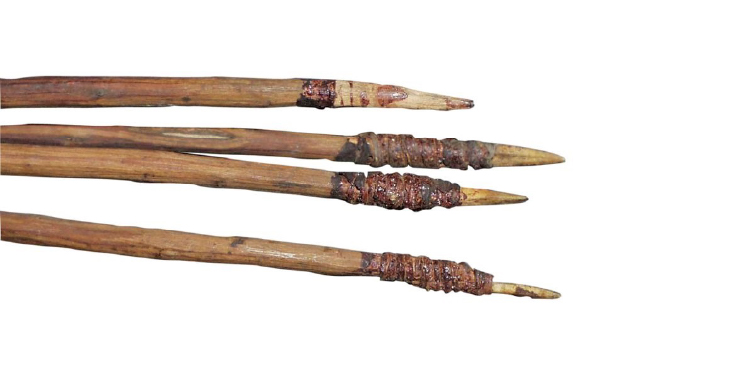
Bark Canoes (“Nuwi”)
Although canoes were used for general transport, they played an integral part in fishing. With an occupancy of four or five people, they were used by the Wallumedegal people in the Paramatta and Lane Cove Rivers. They consisted of a three to four-metre-long piece of bark from the stringybark (Eucalyptus Obliqua) or goomun tree (Casuarina species), tied at both ends with vines or cord.
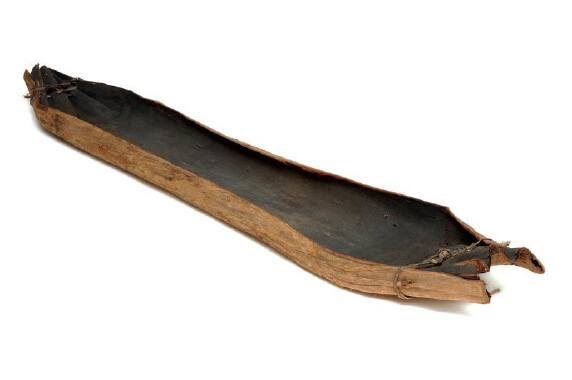
A stone hatchet or axe, mogo, was used to cut the bark. Made from a shaped and sharpened igneous or metamorphic rock, these ground-edged hatchets were secured to a stick using gum. Two goinnia, or paddles, 60-90cm long, were used to move the canoe, and seaweed or fern was used as seating and for maintaining a central fire used for cooking shellfish and fish in the canoe. However, normally the seafood was brought back to shore and enjoyed with their clan.
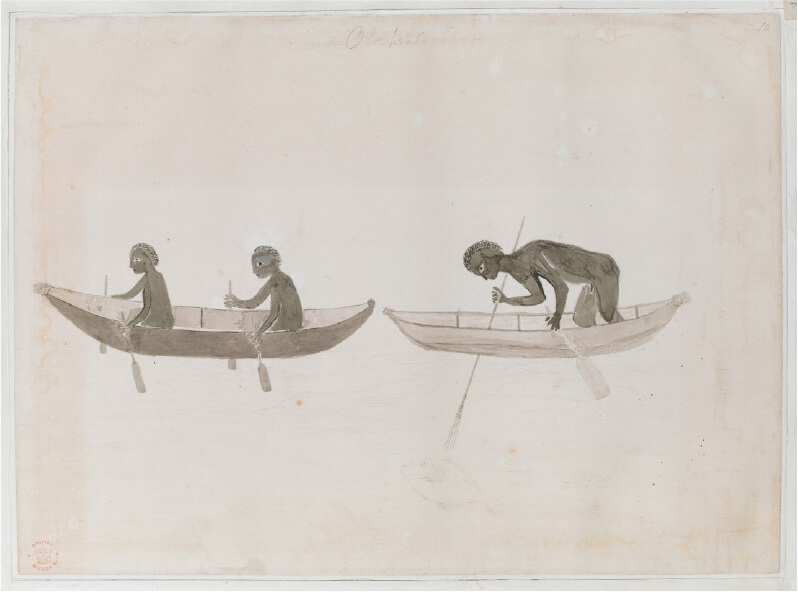
The above drawing by Tupaia shows goinnia being used to move the bark canoes and a man fishing with a multi-pronged spear.
Shellfish
Middens, or domestic waste heaps, found on the Hunters Hill-Woolwich peninsula, indicate that shellfish were an important part of the Wallumedegal diet. However, their robust nature could mean that they are overrepresented in the record. Sydney rock oysters (badangi), hairy mussel (dalgal) and Sydney Cockle (gadyan) were abundant along the shoreline of the Paramatta River. The Wallumedegal people dived for shellfish, removed them from rocks and collected them from the sand and mud of shallow water. A womara, short spear-thrower, was used to lever shellfish off rocks and open them. The shellfish were more nutritious and available in summer and were eaten cooked as well as raw. They were also used as bait, and their shells had a multitude of uses. They were used as vessels to hold and heat water, they were used for necklaces and were also modified for use on tools and weapons.

Hunting and Gathering
In order to facilitate hunting and make the land more productive for the gathering of edible plants, the Wallumedegal people burned pathways through the bush. This technique known as ‘Firestick farming’ involved the lighting of small fires to clear undergrowth, encourage new growth and attract small game. It was particularly common during winter and early spring. It sculpted the Hunters Hill area, with durable and less fire sensitive plant species such as Eucalyptus dominating the landscape.
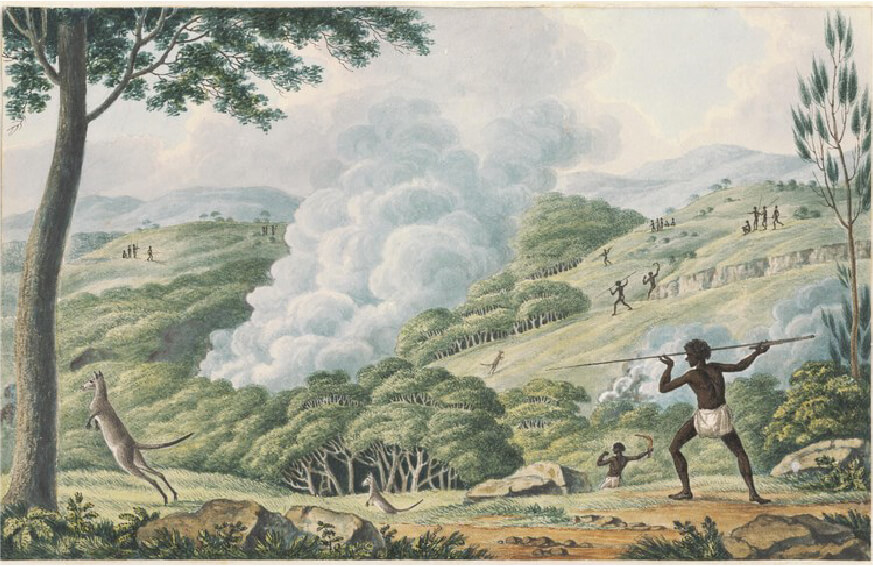
Tools for hunting were portable and multi-purpose, with hunting spears, spear-throwers and axes/hatches also being used as weapons of defence and offence. Although they were similar to fishing spears, the several types of Xanthorrhoea-stem hunting spears only had one prong and one or more barbs made of broken oyster shell, bone or hardwood.

Unlike fishing spears, the Wallumedegal people launched hunting spears using spear-throwers. A womara or a wiggon spear-thrower was used. Both consisted of a short stick with a hook of wood at its end. However, a womara had a split flat shell tip whilst a wiggon had a split rounded shell at its end.

A ground-edged hatchet was not only a useful woodworking tool but was also used for hunting. Its edge was used to extricate possums from trees through manufacturing footsteps or enlarging holes in tree trunks. Other species commonly hunted in the area included kangaroos and parrots.
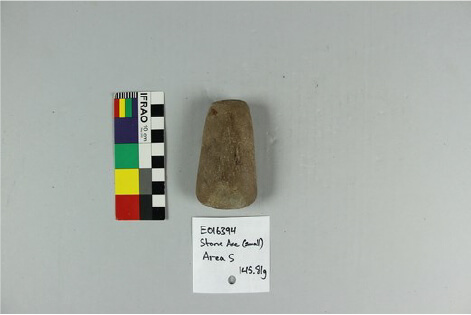
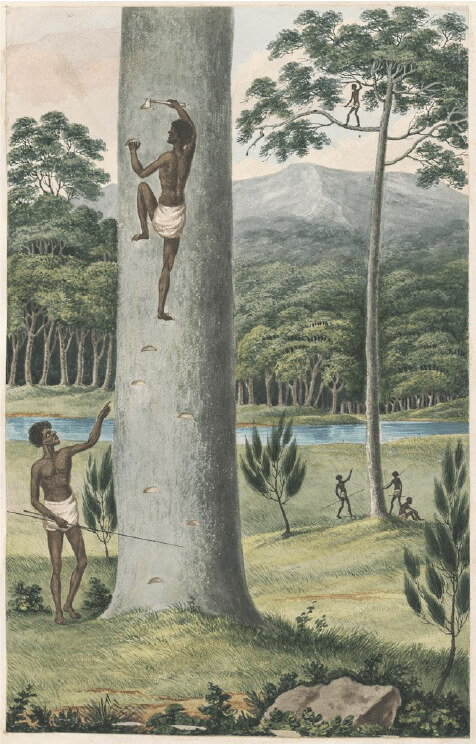
A ground-edged hatchet was also used by the Wallumedegal people to access grubs and honey from inside tree trunks. In 1789 David Collins described worms and grubs from the body of a dwarf gum tree being “A delicacy which I have seen them eager to procure”. The Wallumedegal people would have had access to over 200 species of edible plants, consuming fruit, nectar, flowers, roots, seeds and leaves. However, after the assigning of plots of land to former marines on the Hunters Hill-Woolwich Peninsula on 3 January 1792, these native species were cleared to make way for crops of wheat, maize and barley. With the removal of the native vegetation integral to the Indigenous way of life, traditional gathering and hunting was largely abandoned. In 1794 an unnamed surgeon from the ship Britannia stated that the remaining Wallumedegal people have “become extremely addicted to Indian Corn which they steal with great Boldness”.
Freshwater Sources
Located in a temperate climatic zone, the Hunters Hill/Woolwich Peninsula did not lack drinking water. The Wallumedegal clan relied upon rock pools located on sandstone rock platforms and outcrops because the area was devoid of creeks and rivers. Slabs of rock or branches were used to protect the rainwater which collected in these pools during periods of heavy rain. This protected the pools from sediment and leaf litter which would have decreased the water quality. It also prevented evaporation from occurring during periods of high temperatures.
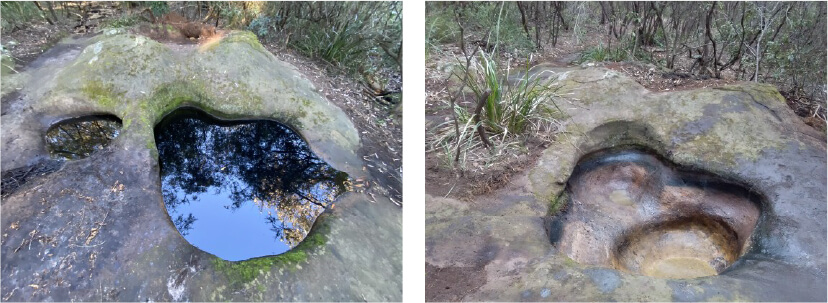
Shelter
The Wallumedegal people lived a mobile lifestyle, never residing in a permanent location. Therefore, various forms of shelter were used, reflecting the resources each area had to offer. According to Sydney archaeologist Dr. Val Attenbrow, three forms of shelter were used in the Sydney region. These included:
- naturally occurring sandstone rock shelters on cliffs and outcrops
- small structures made of bark, branches, bushes or leaves
- large hollowed-out trees
According to Captain John Hunter, rock shelters could house up to 40 or 50 people. Occupation deposits in rock shelters of the Hunters Hill area affirm their use for camping and domestic activities. These floor deposits are known to contain stone artefacts, animal bones and discarded shells.
Campsites, ngurra, provided protection from the elements and were strategically located near food resources or raw materials. To break up their journey when fishing, hunting or gathering, the Wallumedegal people commonly stayed at overnight campsites.
Within many sandstone rock shelters, pigment drawings, paintings and stencils in red (mudjil) and white (dyirra) ochre have been preserved. They depict humans, ancestral beings, animals and objects in a figurative design. Engravings have similar subject matter but are more commonly found on horizontal surfaces outside of these rock shelters. The engravings of the Sydney area are estimated to be up to 5 500 years old.
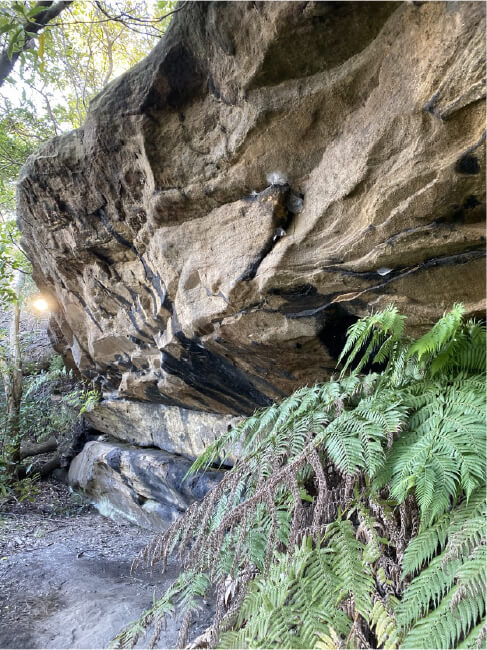
The Smallpox Epidemic (“Mittayon”)
The deadly disease of smallpox, now eradicated, was brought to Australia by the European colonists who arrived in Sydney in 1788. It rapidly spread due to the advancing European settlement. The 1789 smallpox epidemic had a devastating impact on the Wallumedegal clan as they had no previous exposure or resistance to the disease. It resulted in 70% of the Aboriginal population dying from the disease.
Due to the huge demand for burials, traditional practices were not always upheld. Bodies were placed on paths and in rock shelters rather than being
buried, buwabili, alongside grave goods. The skulls of a juvenile and woman were found in two rock shelters near Woolwich Dock and are now in the possession of the Australian Museum.
The epidemic also impacted the social organisation of the Sydney clans due to the Elders, pregnant women and children being most affected. After the April 1789 smallpox epidemic, survivors of the various clans amalgamated to form new groups in order to maintain their Indigenous lifestyle despite a push to adopt European customs.
Assimilation
After the Wallumedegal people had been severely affected by European colonisation, those who survived had to endure assimilation.
Native Institutions in Parramatta and Black Town (Plumpton) lasted from 1814 until 1829. These schools were established by Governor Macquarie. They aimed to instil European ideals in Aboriginal children through teaching reading, writing and religion, in addition to training boys in manual labour and girls in domestic service. Blankets, clothes and shoes were provided as a reward to Aboriginal parents who enrolled their children voluntarily. However, Aboriginal children were also forcibly separated from their families to be placed in these schools. Governor Macquarie also offered land grants to Aboriginal people who agreed to settle and cultivate their assigned plots in an effort to promote assimilation.
Until 1981, Government policies continued to promote assimilation.
Aboriginal Protection Boards had the power to remove Aboriginal children from their families under the 1909 Aborigines Protection Act. They were either placed in institutions such as church missions, or were fostered and adopted by white families. These children were forced to reject their Aboriginal heritage and are known today as The Stolen Generations. This had dramatically impacted the Aboriginal people and their culture. On 13 February 2008 a national apology was made to the members of The Stolen Generations.
Wallumedegal Culture Today
It was not until the 1967 Referendum that Aboriginal people were included in the Census. This has left a large gap in recording the Wallumedegal population of Hunters Hill. However, it is known that after 1840 the number of Wallumedegal members was small. Yet there are descendants of the Wallumedegal people still living in the Sydney region today. More recently, in the 2016 Census, 0.6% of the Hunters Hill population were of Aboriginal descent.
A total of 51 Wallumedegal archaeological traits are concealed along the foreshore of the Hunters Hill area, including middens, rock paintings and engravings, rock pools, shelters, axe-grinding grooves and burials. An extensive study, conducted by Dr. Val Attenbrow in 1988, was instrumental in identifying 47 of these sites which are now registered with the Aboriginal Heritage Information Management System.
Educational Activities
- What was the name Joubert gave to the Hunters Hill-Woolwich Peninsula?
- What rivers acted as boundaries of Wallumetta?
- What language did the Wallumedegal people speak? Are there any speakers remaining?
- Did men and women use different fishing techniques? Describe them.
- What materials did the Wallumedegal people use to build canoes? What were the canoes used for?
- What evidence is there for shellfish being an important part of the Wallumedegal diet?
- Identify some of the uses for shellfish.
- Finish the sentence: Spear-throwers were used to…
- What was firestick farming and what was it used for?
- Hunting spears where not only used for hunting. What else might they have been used for?
- What was a hatchet and what was it used for?
- What traditional Wallumedegal practice endured British Settlement? Why was this?
- Where was drinking water collected and how did the Wallumedegal people maintain its water quality?
- How were rock shelters used? What might be preserved in them?
- Define epidemic. Research the symptoms of smallpox disease and locate the date it was officially eradicated. How did its introduction to Australia affect the Wallumedegal clan?
Recent Responses to Wallumedegal Culture in the Area
Recognising Those who Came Before
To commemorate the Wallumedegal people during the 1988 Bicentennial celebrations, the inlet near Gladesville Reserve was named Wallumatta Bay.
Furthermore, a bronze plaque was erected by Hunters Hill Council. Allan Madden, the educational officer of the Metropolitan Land Council, unveiled the plaque during a ceremony in Gladesville Reserve on 13 April 2002. It was the result of a petition by the group Bennelong and Surrounds Citizens for Reconciliation to “demonstrate that Hunters Hill citizens have a positive attitude to the Aboriginal reconciliation process”. The plaque recognises that the Wallumedegal people were the original custodians of the Hunters Hill area.
Hunters Hill Public School acknowledged the history of the Wallumedegal clan by writing the words of an accompanying interpretive sign.
Consulting the Resources
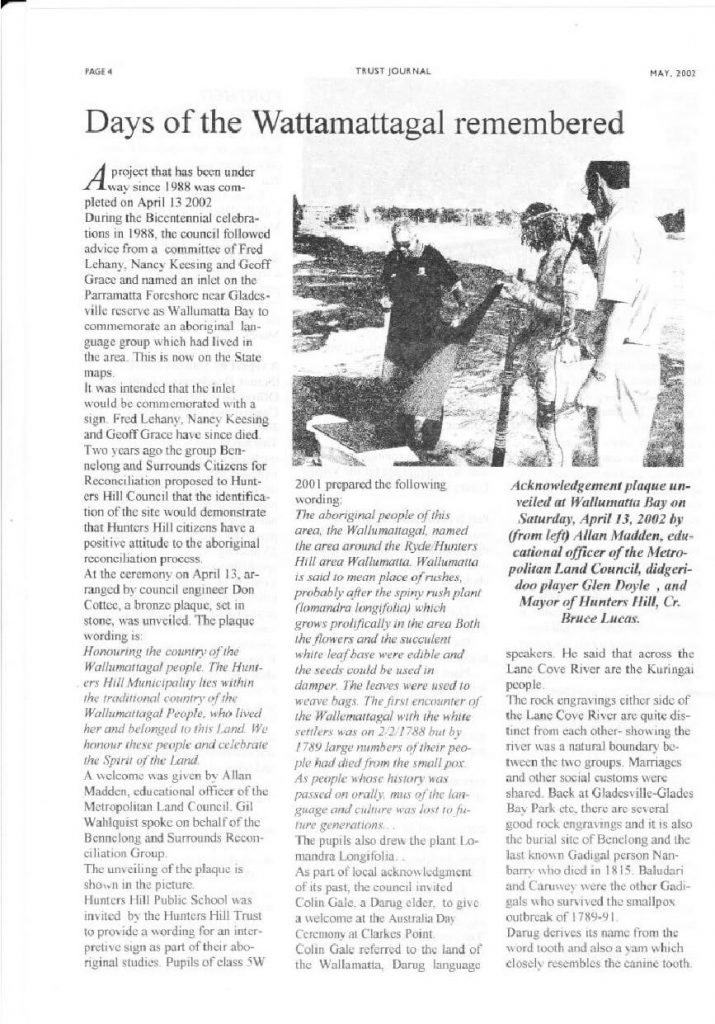

Educational Activities
- How were the Wallumedegal people recognised in 1988?
- Why was the ceremony on 13 April 2002 significant? Who was involved?
- Where else might you have seen an Acknowledgement of Country?
- What does the plaque indicate about the relationship the Aboriginal people had with their land?
- Visit www.reconciliation.org.au/. How can we define reconciliation and how does it relate to Human Rights? Which of the Five Dimensions of Reconciliation are exemplified through the ceremonial unveiling of this plaque?
- Can you think of some other examples of Aboriginal Reconciliation? Research both local and federal responses.
- How might you exercise Aboriginal Reconciliation in your community?
Protecting the Past
In 1969 Hunters Hill Council agreed in principal to the development of 25 dwellings by AV Jennings in the previous “foreshore reserve” known as Kelly’s Bush. Led by local Hunters Hill resident, Betty James, a group of 13 concerned housewives known as “The Battlers for Kelly’s Bush” protested the development of this site. After the official rezoning of land from “Reserved Open Space” to “Residential” in 1971, they were joined by the Builders Labourers Federation (BLF) which called for the first Green Ban. This trade union strike took place on 16 June 1971, aiming to maintain green space. AV Jennings was forced to sell the land to Hunters Hill Council and in 1977 NSW Premier Neville Wran declared that Kelly’s Bush would be saved from future development.
This was a significant achievement, as this pocket of undeveloped bushland is one of three main areas in the Hunters Hill region which show signs of Indigenous occupation. In a Sydney Morning Herald article from 25 July 1970, Betty James described the park as “an outdoor laboratory and living museum: there were Aboriginal middens and carvings in sandstone”. Members of “The Battlers” are shown standing next to one of the rock pools which acted as a freshwater source for the Wallumedegal clan on the Hunters Hill/Woolwich Peninsula.
As a substantially intact area of remnant bushland, it provides a window to a landscape the Wallumedegal people depended upon for food, water and shelter. It appears to have been dominated by eucalyptus, with heath, closed rainforest, banksia and scrub also present.
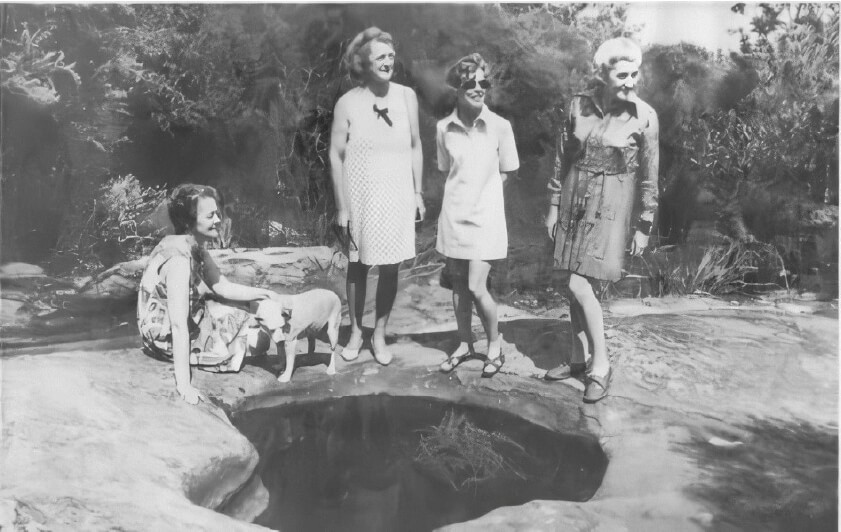
Consulting the Resources
Watch the ABC News Interview with Elizabeth James from 03 June 1971 addressing ‘The fight to save Kelly’s Bush’ by visiting: http://abcspla.sh/m/521045
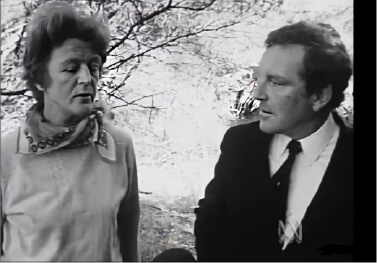
Educational Activities
- Where is Kelly’s Bush located? Have you visited this park before?
- What was AV Jennings attempting to do? Did he have the support of Hunters Hill Council and NSW Premier?
- Who were “The Battlers” and what role did they play?
- Why was it important for Kelly’s Bush to be preserved?
- Do you think Kelly’s Bush is a suitable case study for the preservation versus innovation debate? Explain.
- Form two teams and debate “Should all historical, archaeological and bushland traits in urban areas be preserved?”
- Explore Kelly’s Bush. Can you find any of the archaeological traits pictured in the video? Can you locate some species of flora surviving from pre-colonisation? Ensure you are respectful as everyone has a significant role in conserving the history of Hunters Hill for future generations.
Consulting the Resources
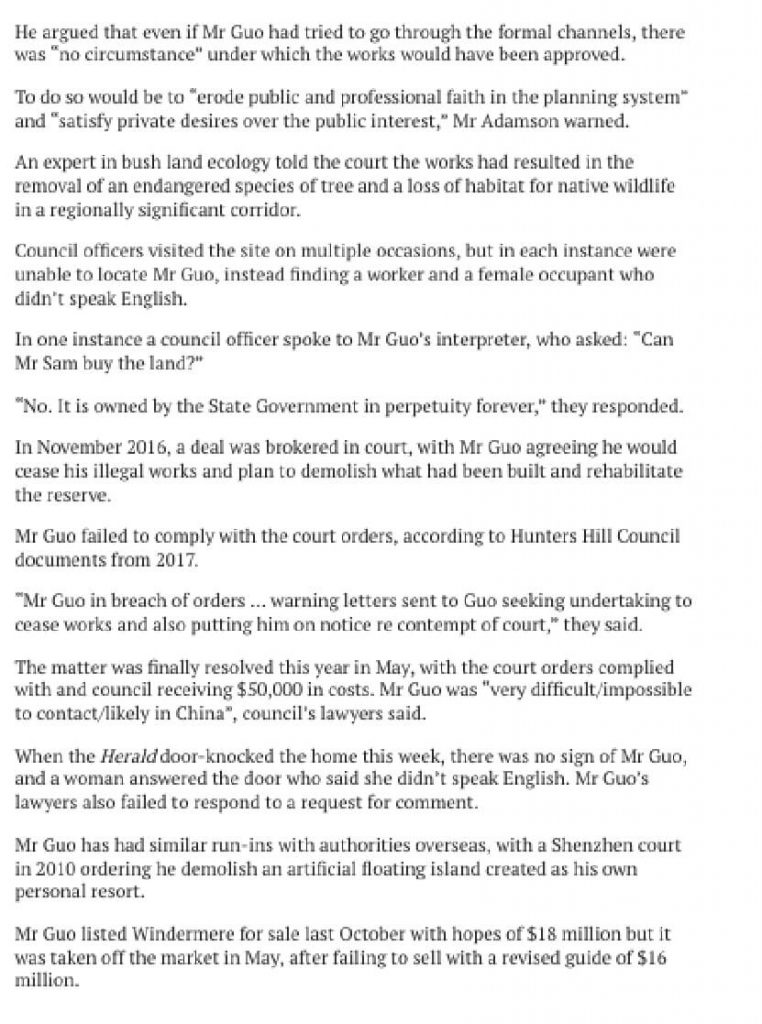
Billionaire Built Bar in Hunters Hill Aboriginal Rock Cave” from November 2019
Educational Activities
- After reading the section on shelters in Wallumedegal Clan: The first residents of Hunters Hill:
- What might have been included in the occupation deposit of this cave?
- How do you think the Wallumedegal people used the cave?
- How was the Wallumedegal cave damaged?
- In what ways do the actions of Mr Guo resemble those of the early colonists?
- Hunters Hill Council ensured it was remedied. What did they order to be done?
- What can this case study teach us about respect, reconciliation and recognition of the Wallumedegal culture and the Aboriginal Community more generally?
Lucy Willeri (“Black Lucy”): An Indigenous Personality from Hunters Hill
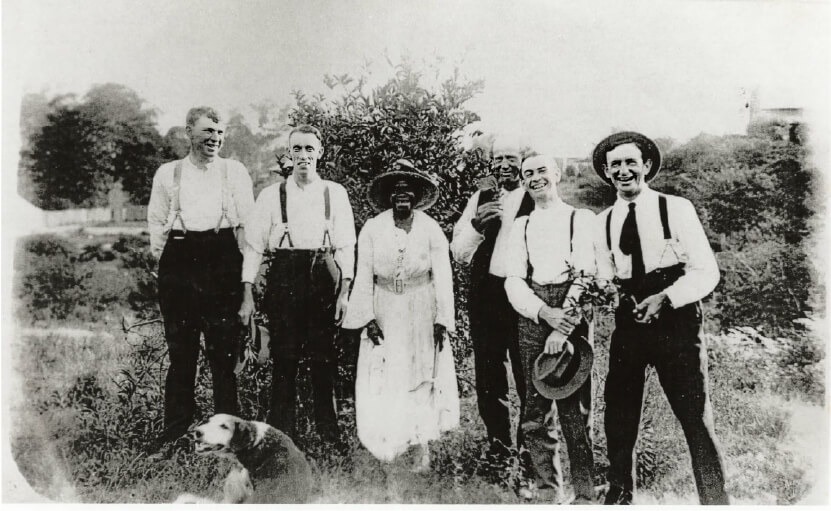
January 1920.
Early Life
Lucy Willeri was an Indigenous woman, born in North Queensland. The date of her birth is not certain. However, she was likely born between 1845 and 1855. As the daughter of “a Queensland King” she was said to be the “Queen of the Alligator River Tribe” or Roper River clan.
Working as a Domestic Servant
1925 interview revealed that “she was taken from the North of Queensland to
Brisbane [by the white settlers] when quite a child and trained to do
housework”. She was then moved to Hunters Hill where she worked as a
domestic servant for several well-known families for a period of 50 years.
Lucy was one of many Indigenous people who were forcibly sent to work as a result of a national government policy which aimed to assimilate Aboriginal people into mainstream society. Boys were trained for work on pastoral properties and girls were trained as domestic servants under so-called apprenticeship schemes enforced by the Aborigines Protection Boards.
According to Colonial Secretary JH Cann, it was “not a question of stealing the
children, but saving them…the young people will merge into the present
civilisation and become worthy citizens”. This led to women, such as Lucy, never
marrying as they were “too young when taken” from their clans. In later years
women were encouraged to marry white men so that their descendants would
be “lighter until they were completely white”. This horrific practice continued
until 1981.
Community Support and a New Home
After her dismissal from working as a domestic servant, Lucy lived in Gladesville with her “cats, dogs, goats and fowls” in a dilapidated humpy made of scrap iron, wood and bags. This humpy was situated on the bank of Tarban Creek and was overgrown with lantana. On 16 February 1925 the NSW Board for the Protection of Aborigines notified Hunters Hill Council of her living conditions and according to a 1925 Sydney Mail article “attempted to move her elsewhere”. The Board had the power to move Aboriginal people out of towns under the 1909 Aborigines Protection Act. However, a movement was started by local residents allowing Lucy to remain in the area. Lucy had expressed that she wanted “to stay there to the end”.

As Lucy was “a well-known and popular figure in Ryde, Gladesville and Hunters Hill”, H. Engrich of the Weekly Times formed a fundraising committee to finance the construction of a new home for her. An entertainment benefit at the Gladesville Theatre endeavoured to raise £100 to put towards this cause. The sociable Lucy was seen attending the event with her pet dogs.
The furnished two-roomed weatherboard cottage on the Fitzpatrick estate in Gladesville was officially handed over to her by the Mayor of Hunters Hill, Alderman Unwin, on 1 August 1925 at 3.30pm. It was a public event open to “anyone who should wish to attend”. Two thousand people showed their support by attending the ceremony and bestowing upon her gifts including “a black kewpie, bunches of flowers, sweets, gloves, cooking pans and groceries”. Lucy allegedly said, “It’s lubly, gentlemen”, when she was asked about her new home.
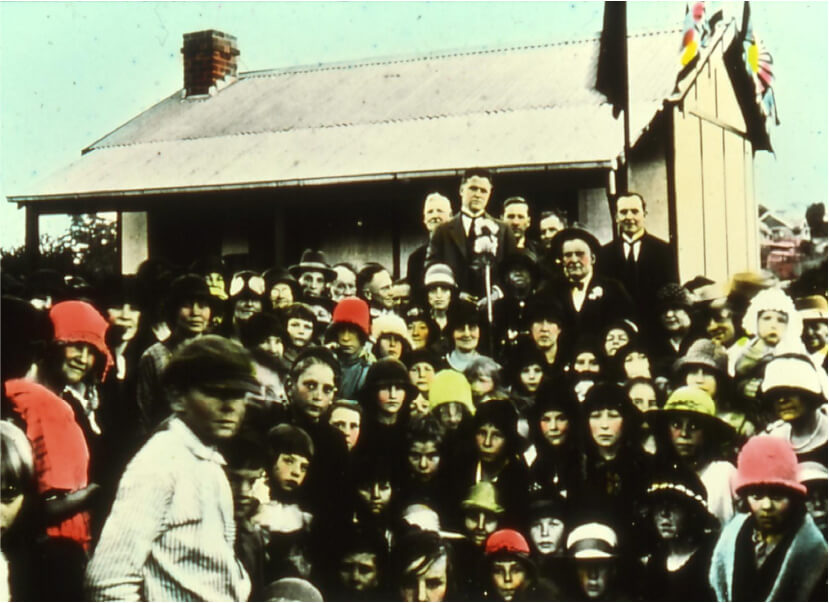
A Sad Loss
The much-loved “Black Lucy” died on 9 September 1928 in a nursing home in Newington after the Mayor of Hunters Hill determined she needed more care. Her funeral took place at the Field of Mars Cemetery in East Ryde. Her home was sold on 12 September 1928 and proceeds were given to the Royal Alexandra Hospital for Children.
Lucy’s life story gives us an important opportunity to reflect on the fate of Aboriginal Australians and their turbulent history. It illuminates the paternalistic attitude towards them during this time period.
Consulting the Resources
These newspaper articles from the 1920s can be accessed from TROVE.
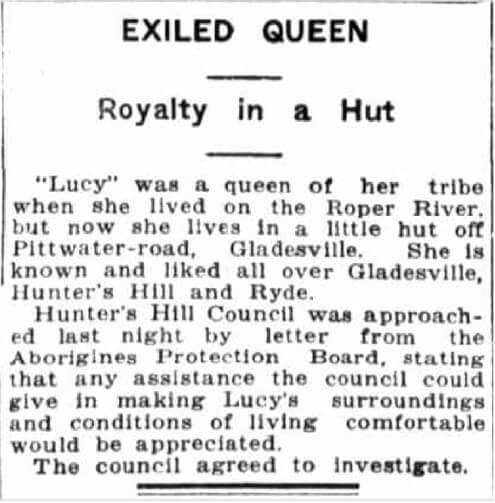
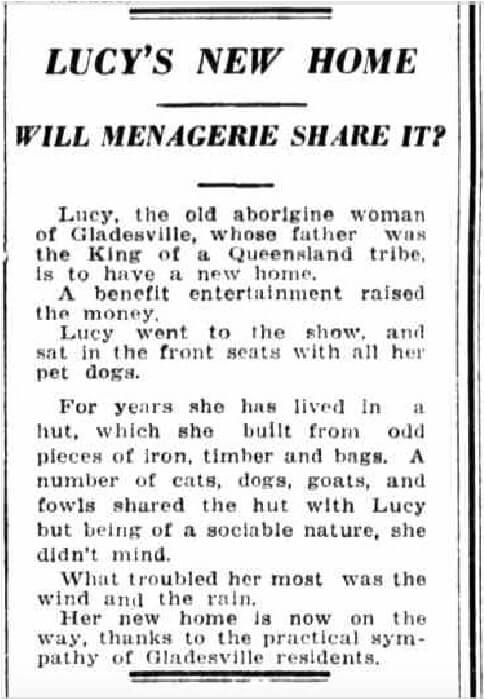
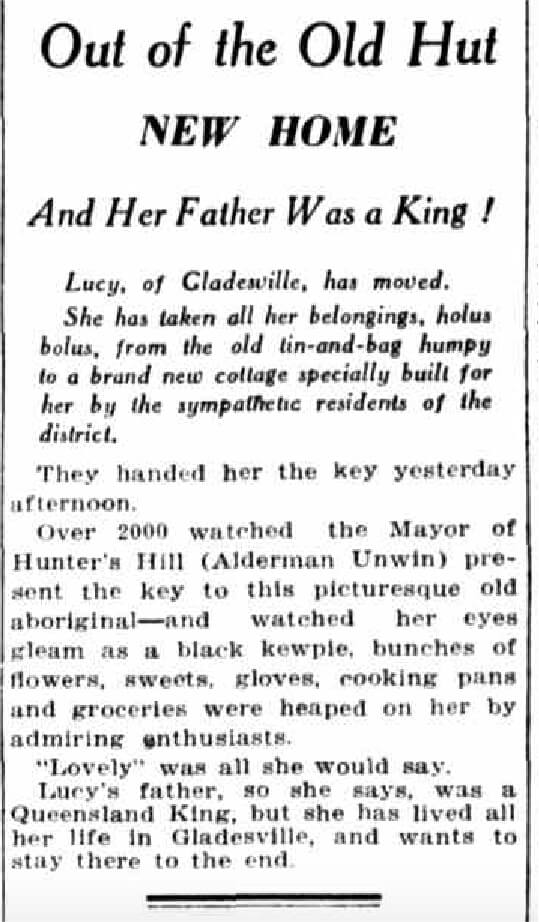
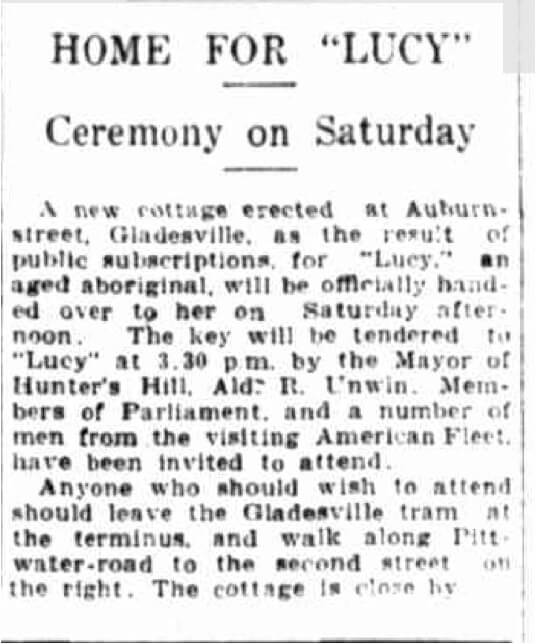
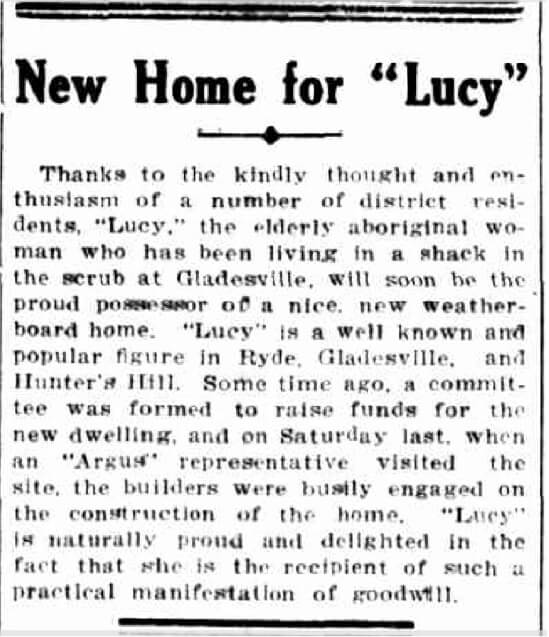
A Home for a True Australian
For years an old aborigine known as Lucy has lived in a dilapidated gunyah at Hunter’s Hill, where she was formerly in the employ of several well-known families as a domestic over a period of about 50 years. Efforts to induce her to leave the locality and be cared for elsewhere by the Aborigines Protection Board proved fruitless, and some of the Hunter’s Hill residents started a movement to provide her with a home. The local council gave assistance, and on Saturday last the Mayor handed to Lucy the key of a two-roomed cottage, comfortably furnished and stocked with provisions. About 2000 people witnessed the ceremony, which took place at Auburn Street, Gladesville. Lucy who was once Queen of the Alligator River (QLD) tribe, and is about 80, is seen in the picture holding a kewpie
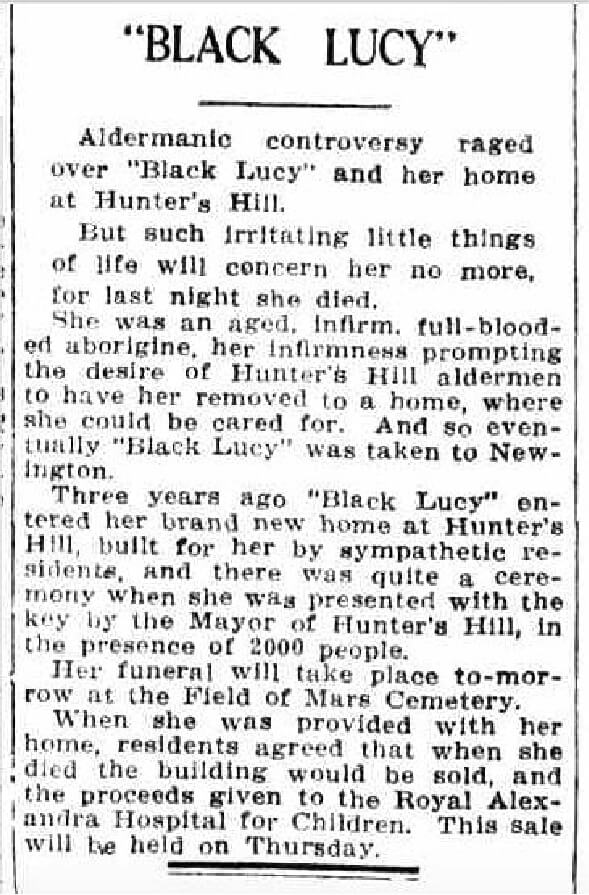
Educational Activities
- What do these articles reveal about the treatment of Indigenous Australians in the 1920s? Can you identify language and terms used which would be considered highly inappropriate today?
- Where did Lucy originally come from?
- Why was a new home built for her by the Hunters Hill community? How were the funds raised?
- When did the cottage-handover ceremony take place and who was involved?
- Community efforts prevented her removal from Hunters Hill, but was she really happy living in a European-style house or do you think she would have preferred to remain in her humpy? Can you think of ways Lucy’s living conditions could have been improved without disregarding Indigenous traditions?
- Was her wish fulfilled, to remain in Gladesville ‘to the end’?
- How did the local community use the proceeds from selling her home? Do you think this reflected the wishes of Lucy?
Further Reading
Attenbrow, V 1988, Research into the Aboriginal occupation of the Hunter’s Hill Municipality, Municipality of Hunters Hill, Hunters Hill.
Attenbrow, V 2010, Sydney’s Aboriginal Past: Investigating the Archaeological and Historical Records, 2nd edn, University of New South Wales Press, Sydney.
Haskins, V 2004, ‘’A Better Chance’? Sexual Abuse and the Apprenticeship of
Aboriginal Girls Under the NSW Aborigines Protection Board’, Aboriginal History, vol. 28, pp. 33-58.
Irish, P 2017, Hidden in Plain View: The Aboriginal People of Coastal Sydney, NewSouth Publishing, Sydney.
Karskens, G 2009, The Colony: A History of Early Sydney, Allen & Unwin, Crows Nest.
Kohen, JL 1993, The Darug and their Neighbours: The Traditional Aboriginal
Owners of the Sydney Region, Darug Link in association with the Blacktown
District Historical Society, Blacktown.
Sherry, B 1989, Hunter’s Hill: Australia’s Oldest Garden Suburb, David Ell Press, Sydney.
Smith, KV 2005, Wallumedegal: An Aboriginal History of Ryde, Community Service Unit City of Ryde, North Ryde.
Troy, J 1994, The Sydney Language, Jakelin Troy, Flynn.
The information in this booklet
was researched and compiled by Rebecca Nisbet, student of
Ancient History at Macquarie University.
The booklet and accompanying exhibition at
Hunters Hill Museum was made possible through the
Department of Industry, Innovation and Science’s
Stronger Communities Program.
Hunters Hill Historical Society acknowledges the support
provided by the Federal Member for North Sydney,
Trent Zimmerman, and Macquarie University.
A special thank you to Auntie Sue Pinckham, Cultural Advisor at
Macquarie University, for ensuring the information is an
appropriate reflection of Aboriginal culture.
Hunters Hill Historical Society Inc
PO Box 98 Hunters Hill NSW 2110
contact@huntershillmuseum.org.au
02 9879 9443
www.huntershillmuseum.org.au
August 2020

